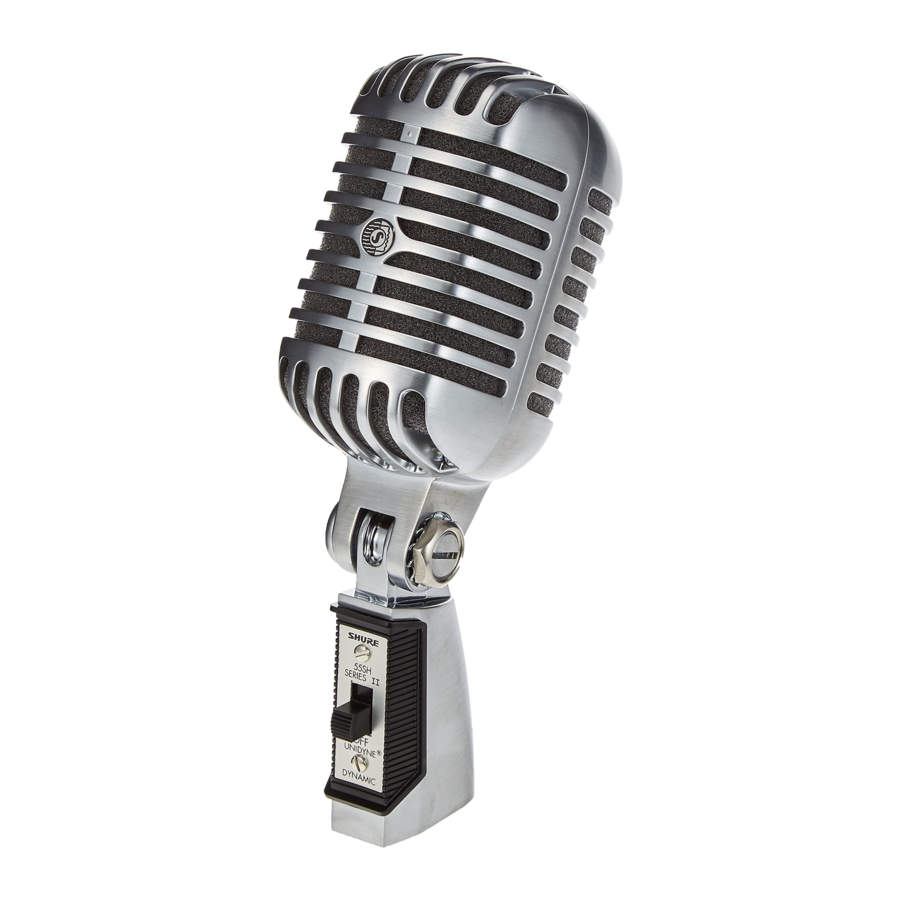
Advertisement

GENERAL
The Model 55SH Series II provides the Shure classic UNlDYNE II design coupled with modern acoustic components to meet today's performance standards. This microphone is excellent for vocal pickup with its characteristic Shure presence peak.
The 55SH Series II has a cardioid (unidirectional) polar pickup pattern that minimizes sound pickup from the rear of the microphone. This allows the Model 55SH Series II to be used in close proximity to loudspeakers without creating feedback problems, and it can perform under adverse acoustic conditions where omnidirectional microphones cannot.
The 55SH Series II has a low-impedance balanced output designed for connection to microphone inputs rated at 75 to 300 ohms. The microphone features a cartridge shock mount to reduce stand noise, an On/Off switch, and an attached, self-tensioning, 5 / 8 "–27 thread swivel mount.
This microphone is ideal for public address or theater– stage sound systems, as well as for broadcasting, recording, and other sound applications where a stand-mounted microphone with a classic look is desirable.
Features
- Classic appearance, modern performance
- Frequency response tailored for speech, vocals and instrumental music
- Cardioid directional pattern for optimum performance in adverse acoustic environments
- Shock–mounted cartridge minimizes stand-transmitted noise, ensures quiet operation
- Rugged die cast case and mechanical design for reliability under rigorous conditions
- Self-tensioning swivel mount, permits tilting through 45 forward and 80 backward
SPECIFICATIONS
Type
Dynamic
Frequency Response
50 to 15,000 Hz (See Figure 1)
TYPICAL FREQUENCY RESPONSE
FIGURE 1

Polar Pattern
Cardioid (unidirectional), uniform with frequency, symmetrical about axis (see Figure 2)
TYPICAL POLAR PATTERNS
FIGURE 2

Impedance
Microphone rating impedance is 150 ohms (270 ohms actual) for connection to microphone inputs rated at 75 to 300 ohms
Sensitivity (at 1,000 Hz)
Open Circuit Voltage. . . . . . . . –58.0 dBV/Pa (1.3 mV)
1 Pascal=94 dB SPL
Polarity
Positive pressure on the diaphragm produces positive voltage on pin 2 relative to pin 3 of the output connector
Switch
Built–in On/Off switch, integral part of swivel mount, connector Three pin professional type, designed to mate with Cannon XL series, Switchcraft A3 (Q.G.) series, or equivalent
Case
Chrome–plated die casting
Dimensions
See Figure 3
OVERALL DIMENSIONS
FIGURE 3

Net Weight
624 grams (22 oz)
POLARITY
To test two microphones and their cables for common polarity, connect them to an amplifier and talk or sing into them while holding them three or four inches apart. The sound from the speakers should be the same when talking into either microphone or directly between them if they have common polarity. If the sound level drops drastically, or if a dead spot is found, when talking between the two microphones, either the microphones or their cables have different polarity. All cables and microphones can be tested in this manner to ensure that they have common polarity.
To reverse the polarity of a low–impedance microphone cable, use either a Shure A15PRS Switchable Phase Reverser or interchange the wires connected to pins 2 and 3 of the connector. To reverse the polarity of a microphone, interchange the cartridge leads (see Figure 4.) This should be performed by your dealer, the Shure Factory Service Department, or other qualified service personnel.
INTERNAL CONNECTIONS
FIGURE 4

OPTIONAL ACCESSORIES
Desk Stand S37A, S39A
Line Matching Transformer A85F, A95UF
Cable and Plug Assembly C25B, C25E, C25J
REPLACEMENT PARTS
Cartridge R115
On/Off Switch RK32S
Plug Element RK169P
For additional service or parts information, please contact Shure's Service department at 1-800-516-2525 or www.shure.com. Outside the United States, please contact your authorized Shure Service Center.
SHURE Incorporated Web Address: http://www.shure.com 5800 W. Touhy Avenue, Niles, IL 60714-4608, U.S.A.
Phone: 800-257-4873 Fax: 847-866-2279
In Europe, Phone: 49-7131-72140 Fax: 49-7131-721414
In Asia, Phone: 852-2893-4290 Fax: 852-2893-4055
Elsewhere, Phone: 847-866-2200 Fax: 847-866-2585
Documents / Resources
References
Download manual
Here you can download full pdf version of manual, it may contain additional safety instructions, warranty information, FCC rules, etc.
Advertisement




















Need help?
Do you have a question about the Series II and is the answer not in the manual?
Questions and answers